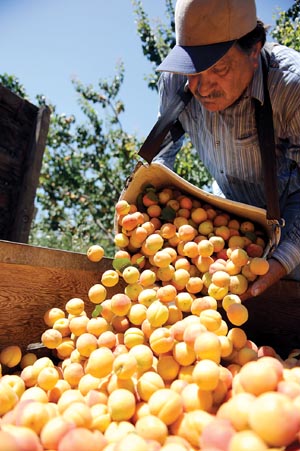Although harvesting for some crops is delayed, it has been a
relatively successful season for the agriculture industry so far in
San Benito County.
Although harvesting for some crops is delayed, it has been a relatively successful season for the agriculture industry so far in San Benito County.
With precipitation levels up this past winter and spring, the harvesting for some crops – such as apricots – was delayed for seven to 10 days, Agriculture Commissioner Ron Ross said. Another fruit crop, cherries, absorbed some damage this year due to the cooler spring.
But as a whole, especially with a healthy season for cattle, it should turn out to be a fairly successful year for agriculture, Ross said. If so, it should have an impact on the economy.
Though the area’s overall crop value dropped by a total of about $50 million in 2008 and 2009 – with the economy undoubtedly playing a role – its worth still approaches $250 million and it stands as the biggest industry in San Benito County.
Drought conditions had hampered the area for a string of years rounding out the past decade, but farmers and ranchers hope that the 2010-11 rainy season is a sign of things to come.
A normal year produces an average of 13.61 inches of precipitation in Hollister. From July 1 of last year through June 30, 2011, there had been 14.55 inches of precipitation at the Hollister station, said Chris Stumpf, a forecaster with the National Weather Service’s Monterey office.
Ross noted how the harvest for apricots is getting started, albeit a bit later than usual.
“Some orchards have a good crop and some are light because they might have been affected by spring rains,” Ross said.
Among other crops harvested earlier than others, cherries took a hit this year and should have a decreased crop – due to the aformentioned precipitation. The cool weather causes “splitting of the fruit,” Ross said.
The lettuce harvest is starting up now as well, while residents will start seeing the same for onions and peppers in another month or so, he said.
Ross underscored a rebound to the cattle industry as a positive sign. With dry conditions in years past, it forced some cattlemen to trim herds. Better grass conditions have meant better productivity.
Still, as one cattlemen noted, it might take a few consecutive years with positive results for the cattle industry to reap the economic benefits.
Jim Warren, co-owner of Livestock 101 in Aromas, said that a normal year will produce about 38.5 million cattle nationwide. That number is down to about 30 million this year, he said.
Locally, the numbers are similar, being down about 20 percent to 30 percent, he said. Because of the breeding cycle – it takes about three years – that’s how long it takes for significant increases or decreases to the herd, Warren said.
He also pointed to landowners using rangeland for other purposes, such as growing vegetables, and housing growth as two other reasons numbers can drop.
Although a turnaround can’t occur overnight, though, there are positive signs.
“In this past year, there was good grass and good cattle prices,” he said. “That’s something we don’t get very often.”










